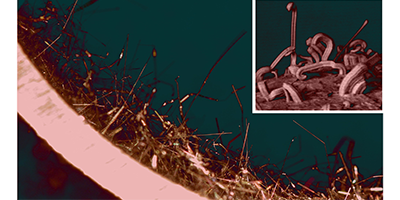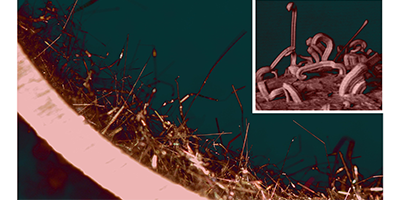Growing Whiskers
Various metals widely used in electronics, such as tin and zinc, often show hairlike protrusions on their surfaces. These “whiskers” can be responsible for current leakage and short circuits in electronic equipment, causing billion-dollar losses in the auto, aviation, and space industries. But the formation mechanism of whiskers has remained a mystery for over years and researchers have been unable to provide even order-of-magnitude predictions of whisker parameters.
Previous theories offered a qualitative explanation of the growth of a whisker, based on the gain in energy due to the whisker’s needlelike structure. Now, Victor Karpov at the University of Toledo, Ohio, has proposed a theory that provides, for the first time, quantitative estimates of whisker nucleation, growth rates, and length distributions. Karpov, as reported in Physical Review Applied, derived a theory of whisker evolution based on equations describing how local electric fields originating from defects or contaminations in the proximity of a metallic surface can trigger whisker nucleation. The calculations revealed that whiskers evolve through a nucleation stage, a slow growth period, a faster growth period, and a phase of winding or kinking. The observed whisker statistics are related to the randomness of electric fields generated by charge patches on imperfect metal surfaces.
Karpov’s analysis delivers estimates of whisker parameters that are generally consistent with observations and explains many aspects of whisker growth and morphology. Further research will be needed to understand other open questions, such as how whiskers interact with each other to limit or promote their growth. The development of more reliable models of whisker evolution will be useful not only for microelectronic technologies, but also for large-area photovoltaics, where whiskers acting as shunts can cause device failures. – Katherine Kornei





